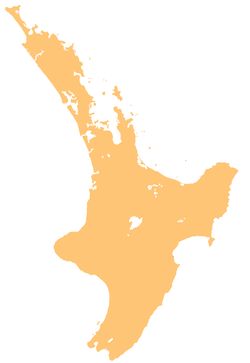Whangamata
| Whangamatā | |
|---|---|
| Coordinates: 37°12′50″S 175°52′19″E / 37.21389°S 175.87194°E | |
| Country | New Zealand |
| Region | Waikato |
| District | Thames-Coromandel District |
| Population (June 2016) | |
| • Total | 3,790 |
| Postcode(s) | 3620 |
The town of Whangamatā is sited on the southeast coast of the Coromandel Peninsula in the North Island of New Zealand. It is located 30 kilometres north of Waihi, to the north of the western extremity of the Bay of Plenty.
The population of Whangamatā was 3471 in the 2013 Census, a decrease of 84 from 3555 in the 2006 Census, and a decrease of 492 from 2001. In holiday times the population swells considerably: New Year's celebrations fill the town to over 25,000 though this falls soon after New Year's Day.
A number of off-shore islands can be seen from the beach. Hauturu or Clark Island is accessible by wading at low tide and is popular in summer months for rock-pool fossickers and kayakers. Whenuakura, sometimes known as Donut Island, sits about a kilometre east of the southern part of Whangamatā beach (Otahu Beach). Tuatara roamed on Whenuakura until fairly recently. Whenuakura Island has a large collapsed blow hole which has formed a small beach inside the island - hence the alternative name.
The town has two ocean beaches, both of which are extremely safe for swimming and surfing. There is a safe boating harbour at the North end of the town and another estuary at the South end. 15 minutes drive south of Whangamatā is the quietly popular beach Whiritoa. Other beaches just north of Whangamatā are Onemana and Opoutere.
The name of Whangamatā comes from the Māori words 'whanga', which means bay, and 'matā', which means a hard stone, in reference to the obsidian which washes up on the beach.
Whangamatā Area School is a coeducational composite (year 1–13) school with a roll of approximately 387 students.
A controversial marina has been constructed on the Whangamatā Estuary. The Whangamatā estuary is the shallowest on the North Island, with approximately 75% of the estuary’s water volume leaving on the low tide. The new marina basin at low tide is below sea level. Since the consent was granted, many new, and non-notified consents have been granted, including that the boat channel no longer has to be rock walled, meaning that a great deal more marine material is to be permanently removed from the estuary's sedimentary cycle. Surfers, environmentalists and Māori have opposed the marina due to the effects upon a major wetland area and the risk to a world-class left hand surf break. An Environment Court hearing stipulated that the marina could go ahead as long as certain conditions were met. Chris Carter, a former Minister of Conservation, blocked the development but his decision was judicially reviewed by the marina developers.
...
Wikipedia

